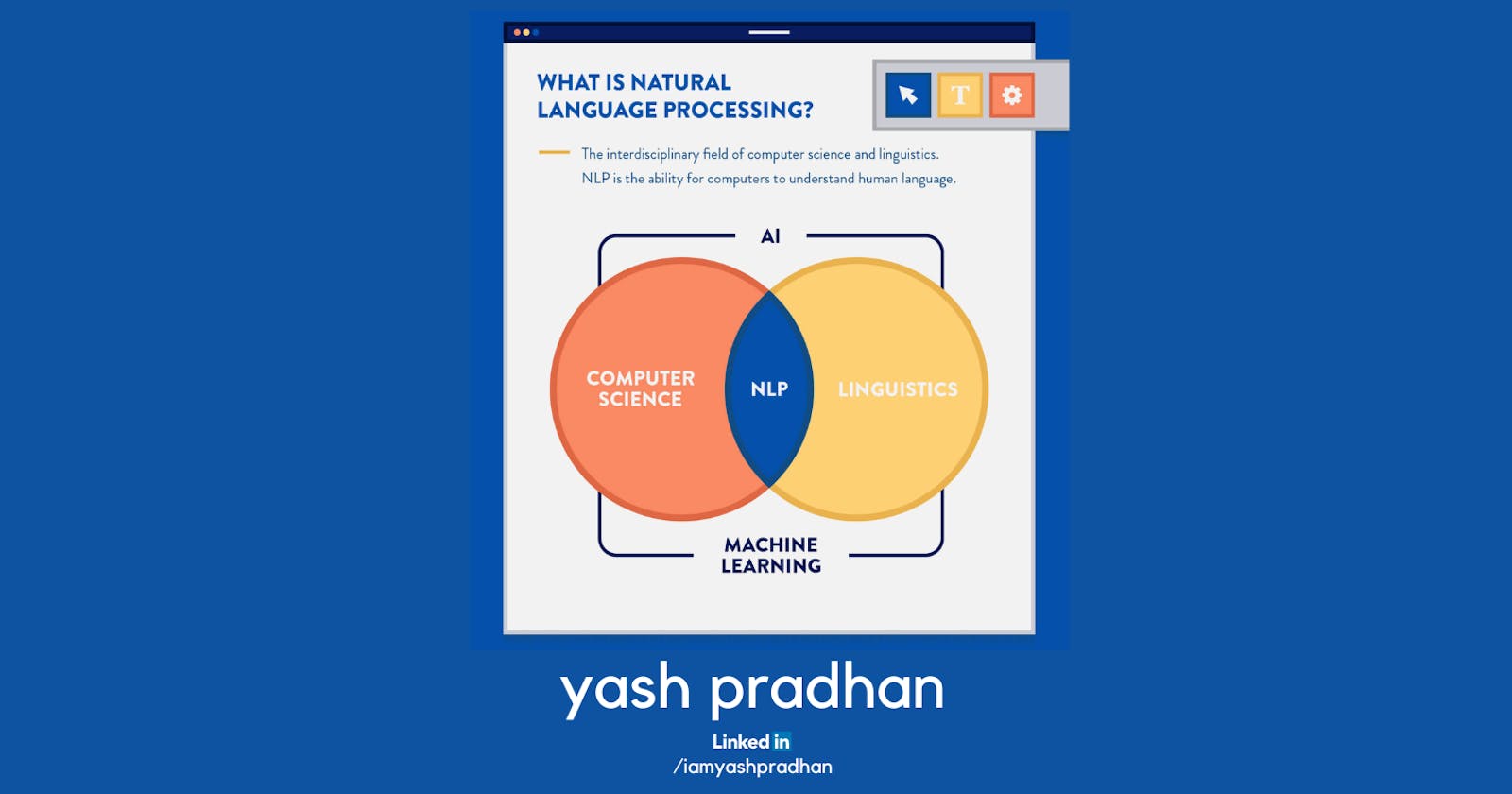What is NLP?
Natural Language Processing (NLP) is a field of study in artificial intelligence (AI) and computer science that focuses on enabling computers to understand, interpret, and generate human language. NLP uses a combination of machine learning algorithms and linguistic rules to analyze and process natural language data. The goal of NLP is to create computer systems that can understand human language as it is spoken or written.
In layman's terms, Natural Language Processing (NLP) is a way for computers to understand and interpret human language, just like humans do. NLP works by breaking down human language into smaller pieces called tokens, which are individual words or groups of words that have meaning. The computer then uses rules and algorithms to analyze these tokens and understand their context and meaning in a sentence.
For example, if you tell your voice assistant “Play some music”, the computer will break down the sentence into tokens like “play”, “some”, and “music”, and then use its programming to understand that you want it to play some music.
NLP can also be used to analyze the sentiment or emotion behind a piece of text, like a social media post or product review. The computer can use its algorithms to identify positive, negative, or neutral language, which can be useful for businesses to understand how their customers feel about their products or services.
Major Application in our daily life:
Whenever you search for something on Google, after typing 2–3 letters, it shows you the possible search terms. Or, if you search for something with typos, it corrects them and still finds relevant results for you. Isn’t it amazing?

Google Search
It is something that everyone uses daily but never pays much attention to it. It’s a wonderful application of natural language processing and a great example of how it is affecting millions around the world, including you and me. Search autocomplete and autocorrect both help us in finding accurate results much more efficiently. Now, various other companies have also started using this feature on their websites, like Facebook and Quora.
The driving engine behind search-autocomplete and autocorrect is the language models. You can read more about language models in this article: A Comprehensive Guide to Build your own Language Model in Python
Other Major Applications:

Nexocode: The 2022 Definitive Guide to Natural Language Processing (NLP)
Voice assistants: Voice assistants such as Siri, Alexa, and Google Assistant use NLP to understand and respond to voice commands.
Language translation: NLP is used to automatically translate text from one language to another. For example, Google Translate uses NLP to translate text between over 100 different languages.
AutoCorrect and Auto Prediction: There is much software available nowadays that checks the grammar and spelling of the text we type and save us from embarrassing spelling and grammatical mistakes in our emails, texts or other documents. NLP plays an important role in that software and functions. This is one of the most widely used applications of NLP. This software offers a lot of features like suggesting synonyms, correcting grammar and spellings, rephrasing sentences and giving clarity to the document and can even predict the tone of the sentence that might be implied by the user.
Sentiment analysis: NLP can be used to analyze the sentiment of social media posts, customer reviews, and other forms of online content. This allows businesses to understand how customers feel about their products and services.
Spam filtering: NLP is used to filter out spam emails and messages by analyzing the content and identifying common spam patterns.
Chatbots: NLP is used to power chatbots, which are automated customer service agents that can handle common queries and provide support to customers.
Text summarization: NLP is used to automatically summarize long articles, research papers, and other forms of written content.
Techniques and Methods to implement NLP

NLP Implementation Flow
Syntax and Semantic analysis are two main techniques used in natural language processing.
Syntax is the arrangement of words in a sentence to make grammatical sense. NLP uses syntax to assess meaning from a language based on grammatical rules. Syntax techniques include:
Parsing. This is the grammatical analysis of a sentence. Example: A natural language processing algorithm is fed the sentence, “The dog barked.” Parsing involves breaking this sentence into parts of speech — i.e., dog = noun, barked = verb. This is useful for more complex downstream processing tasks.
Word segmentation. This is the act of taking a string of text and deriving word forms from it. Example: A person scans a handwritten document into a computer. The algorithm would be able to analyze the page and recognize that the words are divided by white spaces.
Tokenisation. This places sentence boundaries in large texts. Example: A natural language processing algorithm is fed the text, “The dog barked. I woke up.” The algorithm can recognize the period that splits up the sentences using sentence breaking.
Morphological segmentation. This divides words into smaller parts called morphemes. Example: The word untestably would be broken into [[un[[test]able]]ly], where the algorithm recognizes “un,” “test,” “able” and “ly” as morphemes. This is especially useful in machine translation and speech recognition.
Stemming. This divides words with inflexion in them to root forms. Example: In the sentence, “The dog barked,” the algorithm would be able to recognize the root of the word “barked” is “bark.” This would be useful if a user was analyzing a text for all instances of the word bark, as well as all of its conjugations. The algorithm can see that they are essentially the same word even though the letters are different.
Semantics involves the use of and meaning behind words. Natural language processing applies algorithms to understand the meaning and structure of sentences. Semantic techniques include:
Word sense disambiguation. This derives the meaning of a word based on context. Example: Consider the sentence, “The pig is in the pen.” The word pen has different meanings. An algorithm using this method can understand that the use of the word pen here refers to a fenced-in area, not a writing implement.
Named entity recognition. This determines words that can be categorized into groups. Example: An algorithm using this method could analyze a news article and identify all mentions of a certain company or product. Using the semantics of the text, it would be able to differentiate between entities that are visually the same. For instance, in the sentence, “Daniel McDonald’s son went to McDonald’s and ordered a Happy Meal,” the algorithm could recognize the two instances of “McDonald’s” as two separate entities — one a restaurant and one a person.
Natural language generation. This uses a database to determine the semantics behind words and generate new text. Example: An algorithm could automatically write a summary of findings from a business intelligence platform, mapping certain words and phrases to features of the data in the BI platform. Another example would be automatically generating news articles or tweets based on a certain body of text used for training.
Functions in Real-World Applications:
Text classification. This involves assigning tags to texts to put them in categories. This can be useful for sentiment analysis, which helps the natural language processing algorithm determine the sentiment, or emotion behind a text. For example, when brand A is mentioned in X number of texts, the algorithm can determine how many of those mentions were positive and how many were negative. It can also be useful for intent detection, which helps predict what the speaker or writer may do based on the text they are producing.
Text extraction. This involves automatically summarizing text and finding important pieces of data. One example of this is keyword extraction, which pulls the most important words from the text, which can be useful for search engine optimization. Doing this with natural language processing requires some programming — it is not completely automated. However, there are plenty of simple keyword extraction tools that automate most of the process — the user just has to set parameters within the program. For example, a tool might pull out the most frequently used words in the text. Another example is named entity recognition, which extracts the names of people, places and other entities from text.
Machine translation. This is the process by which a computer translates text from one language, such as English, to another language, such as French, without human intervention.
Natural language generation. This involves using natural language processing algorithms to analyze unstructured data and automatically produce content based on that data. One example of this is in language models such as ChatGPT4, which are able to analyze an unstructured text and then generate believable articles based on the text.
Benefits:
There are many benefits of NLP, but here are just a few top-level benefits that will help your business become more competitive:
Perform large-scale analysis. Natural Language Processing helps machines automatically understand and analyze huge amounts of unstructured text data, like social media comments, customer support tickets, online reviews, news reports, and more.
Automate processes in real time. Natural language processing tools can help machines learn to sort and route information with little to no human interaction — quickly, efficiently, accurately, and around the clock.
Tailor NLP tools to your industry. Natural language processing algorithms can be tailored to your needs and criteria, like complex, industry-specific language — even sarcasm and misused words. There are many benefits of NLP, but here are just a few top-level benefits that will help your business become more competitive:
Perform large-scale analysis. Natural Language Processing helps machines automatically understand and analyze huge amounts of unstructured text data, like social media comments, customer support tickets, online reviews, news reports, and more.
Automate processes in real time. Natural language processing tools can help machines learn to sort and route information with little to no human interaction — quickly, efficiently, accurately, and around the clock.
Tailor NLP tools to your industry. Natural language processing algorithms can be tailored to your needs and criteria, like complex, industry-specific language — even sarcasm and misused words.
Credits:
Analytics Vidhya, Monkey Learn, Tech Target, Analytics Steps, Nexocode, CleverTap

